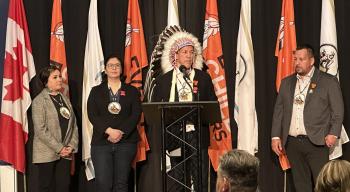Image Caption
Local Journalism Initiative Reporter
Windspeaker.com
A potential new deal with Suncor Energy could generate up to $2.25 billion in royalties for Fort McKay First Nation over five years if full bitumen production is realized from a lease on reserve land.
It’s an estimated figure based on a concept, said Chief Raymond Powder, which is dependent on the price of West Texas Intermediate, a grade of crude oil, with a barrel of oil set at $60, $75 or $90.
A memorandum of understanding on a prospective oil sands lease was signed March 7 between the northern Alberta First Nation and Suncor.
The MOU was made possible after Indigenous Services Canada passed Regulations Amending the Fort McKay First Nation Oil Sands Regulations last December. The amendment saw Reserve No. 174C, which is the prospective oil sands lease with Suncor, included as part of the Fort McKay Settlement (Oil Sands Lands). The amended regulations are part of the First Nations Commercial and Industrial Development Act (FNCIDA), which Fort McKay First Nation opted into in 2007. FNCIDA regulations are a First Nation-driven, opt-in option to support on-reserve economic opportunities.
The move to explore the opportunity is in keeping with the direction set by Fort McKay nation members in 2003. And 21 years later, despite pushes to pursue green energy, Powder believes that direction still has merit.
He contends that green energy is still new in both Canada and around the world and is still in the infancy stage.
“We'll probably need (oil) for, at least for sure, in the next three decades. And so, as a result of that, we want to be able to have that full participation in that and be partners in this whole process in this project,” said Powder.
It was a sentiment expressed as well by Energy Minister Brian Jean, also MLA for Fort McMurray-Lac la Biche.
“Alberta recognizes that the world will need more oil and gas for decades to come. And we intend to empower Albertans, including Indigenous communities, to deliver to the world. Whether it’s oil, gas or lithium, we will continue to work to ensure that the entire world knows that Alberta is energy and energy is Alberta,” Jean said at the announcement.
Powder said there is value in moving quickly on this exploration work.
“We actually want to develop now and get on quite as early as possible because of the fact that we want to grow as a nation and as a result of that growth, we want to be able to have the ability to have great outcomes,” said Powder.
The development would also lead to more employment for nation members, he says.
If technical and commercial feasibility assessments to determine the quality and quantity of bitumen are favourable, Powder expects production could begin as early as 2036.
Fort McKay First Nation has had a long relationship with Suncor, which Powder refers to as a “good history.”
In that time, the relationship has grown and “our revenues (have) increased with respect to Suncor, and Fort McKay has actually benefited that way,” said Powder.
Fort McKay’s economic opportunities have not all focused solely on on-reserve developments.
In 2017 Fort McKay and Mikisew Cree First Nations acquired a 49 per cent partnership interest in Suncor’s East Tank Farm Development for total proceeds of $503 million. The tank farm is located approximately 30 kilometres north of Fort McMurray in the Rural Municipality of Wood Buffalo.
Fort McKay is also an equity partner with 22 other Indigenous communities with an 11.57 per cent interest in seven Enbridge-operated pipelines in the Athabasca region of northern Alberta at a cost of $1.12 billion.
Local Journalism Initiative Reporters are supported by a financial contribution made by the Government of Canada.

